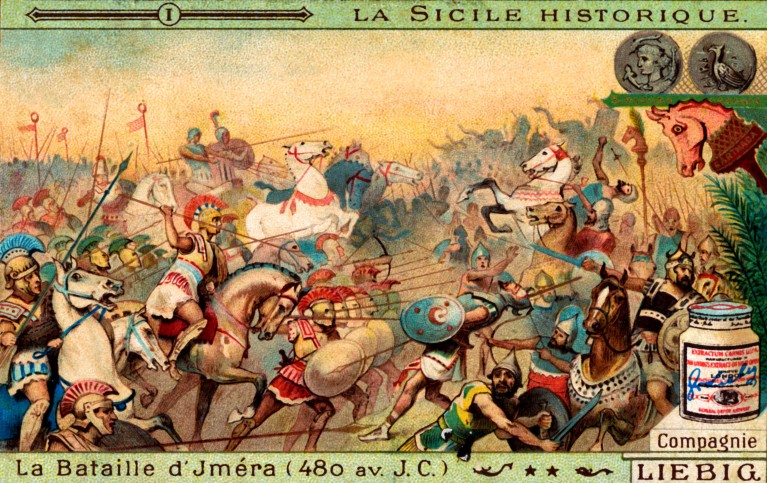
The Battle of Himera, 480 BC, in an illustration found on a Liebig collectible card in French, from the series 'La Sicile historique'. Credit: Lebrecht Music & Arts / Alamy Stock Photo.
A genetic analysis shows that mercenaries could have played a larger role in ancient Greek armies than historians have so far estimated.
A study of ancient DNA from the remains of nearly 20 soldiers buried in mass graves in the necropolis of Himera, a Greek colony in northwestern Sicily, revealed the presence of migrants who came from Eurasian regions very far from Sicily and Greece.
The remains date back to the fifth century BCE, when Himera was attacked twice by the Carthaginians. In the first battle of 480 BCE, the Himerans prevailed with the aid of two other Greek colonies, Agrigento and Syracuse, whose tyrants could afford to hire mercenaries as bodyguards to maintain control over their cities.
In the second battle of 409 BCE, the Himerans fought alone and succumbed to the Carthaginians. The genetic analysis shows that soldiers from the second battle were only of Sicilian and Greek ancestry, whereas those associated with the first one had a more diverse ancestry.
“Our results reaffirm the importance of mercenaries”, says David Caramelli, anthropologist at the University of Florence and one of the leading authors of the study1. “They were considered as inferior to the heroic Greek citizen soldiers, but their contribution may have been decisive for the victory in the first battle.”
Historians have largely downplayed the role of paid professional soldiers in the Greek classical period. However, in 2021 an analysis of isotopes in the tooth enamel extracted from the remains of nearly 60 soldiers at the Himera site, indicated that non-local individuals fought in the first battle, whereas only locals were involved in the second one2.Isotopic data reflect the hydrology and geology of the place where a person is born and raised, but cannot give any information on the geographical origin of their ancestors.
To answer this question, the new study has compared genome-wide data from a subset of the 60 soldiers studied in 2021, including 16 soldiers involved in the first battle and five soldiers of the second battle, using genetic data of both ancient and present-day individuals from Europe, the Caucasus, and Central Asia as a reference
Seven soldiers from the 480 BCE battle and all the five soldiers from the 409 BCE battle descend from the Greeks and the Sicani, the indigenous population who inhabited Sicily before the colonization. These data suggests that they “were plausibly the descendants of Greek colonizers of Sicily and that intermarriage between Greeks and Sicilian locals was practiced,” the authors write.
Instead, the remaining nine soldiers of the 480 BCE battle have ancestors who belonged to populations originating from Central Europe, Lithuania, the Caucasus, and Central Asia. Correlating genetic and isotopic data, researchers conclude that soldiers with non-Greek ancestry were born far away from Sicily, and were probably first-generation migrants.
This hypothesis is also supported by the fact that the soldiers of Greek ancestry were found buried together and with greater care in a specific area of the necropolis, whereas the remains of the genetically more diverse group were found in another area, where more corpses were buried, often after being dragged.
This suggests that the first area was destined to soldiers who had greater prestige among the survivors, “but an individual's cultural identity, that can be inferred from archaeological markers such as funerary artifacts, may not match their genetic ancestry,” says Silvia Ghirotto, an anthropologist at the University of Ferrara who was not involved in the study, “that is why the analysis of ancient DNA has been decisive to understand the origin of those soldiers."
